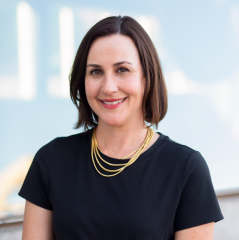Opening new lines of communication: The project
by Kristy Roschke, Celeste Sepessy and Gail Rhodes
The following case study is from an academic paper presented at the Engaged Journalism Pre-Conference at the 2019 International Communication Association annual conference. This blog post series presents a condensed version of the study’s findings. Read the first post here.
At the onset of the partnership with the News Co/Lab, three groups in Fresno were surveyed—community members, news sources, and Bee journalists—to establish baselines for perceptions of local news and level of community news fluency1, which would then inform the design of engagement initiatives.
The Bee formed a working group of members of its newsroom and other community leaders to discuss salient issues in Fresno and design experiments around increased trust and transparency. The project with Spaceship Media, named “Crossing the Line,” was developed in response to survey results that found respondents are not as good at identifying news or opinion content as they think they are, and respondents rated the Bee lower than average in trust-related attributes like fairness, transparency, and engagement2.
The Crossing the Line project grew out of the Fresno Bee’s broader focus on increasing transparency in its reporting to counter growing distrust for local news. Spaceship’s fees were paid for by the News Co/Lab as part of its partnership with the Bee.
After project lead reporter Brianna Calix came on to the project, the group identified an important geographic divide, Shaw Avenue, as one that has many historical, social, and political implications for the city. Calix took on responsibility for the project because she had an interest in getting back into the community. In her role as city hall reporter, Calix acknowledged she talks to a lot of politicians, and doesn’t always get to talk to residents as much as she would like. She recognized the importance of connecting with the community:
So I think it’s important for people … to see us like out in the community doing this work and even just showing them that we are trying to engage the community and we care about their experiences and we want to tell those stories. I think that’s really important and that sends a really good message.
In her first article about the project, which served to set the stage and invite people to participate, Calix described her goal as “to help people from different parts of the city understand each other. I hope this dialogue process also builds trust in the journalistic process”. Bee Editor Joe Kieta said about the project:
My goal was to basically get the ball rolling on this and make connections with the community and get all those names of people who came in and their email. I knew there was no way we were going to solve the north of Shaw and south of Shaw divide in one event, but I wanted to get people talking. I think the Bee has this convening power that we have to use, and that was one way that we used it. It is hard not to use that. We have to use it wisely, I’m trying to say. That was a wise way to use it. I want to try more ways that we can get people together and we were able to pull that off. It is a beginning not an ending. We need to figure out what the next steps are.
The demographic breakdown of the 83 people who responded to the initial survey is:
- 54% male, 46% female;
- 57% white, 43% people of color; and
- 4% age 18-24, 50% 29-44, 33% 45-64, and 13% 65+.
Based on U.S. Census data for Fresno, men and people over 65 were overrepresented in this group, but the racial/ethnic breakdown was similar to that of the entire city.
The post-survey given at the end of the project was completed by a subset of the original 83 respondents. Such small numbers do not allow for statistical inference; however, the information gleaned from the surveys can be examined as qualitative data to offer a more comprehensive picture of the experience.
Calix recruited participants through the article in the Bee and promotion on social media. Ensuring a diversity of voices was key to the project, but proved somewhat difficult. She made a concerted effort to recruit a broad group of people from north Fresno, which was described by residents as an affluent and predominantly white part of town, and south Fresno, which was characterized as being more diverse and less affluent.
A month-long, conversation moderated by the Bee with guidance from Spaceship Media ensued, including two in-person meetings and an ongoing Facebook group discussion. Nearly 300 residents from north and south of Shaw Avenue participated in opinion polls and some part of the discussion.
The project culminated in an in-person event that brought together approximately 100 of the participants. A subset of participants answered a post-survey about their views on the experience and their perceptions of the Bee.
Throughout the project, the Bee updated its readers on common themes emerging from the conversations and the working group through written articles and social media promotion.
References
1. Rosenstiel, T. and Elizabeth, J. (May 9, 2018). Journalists can change the way they build stories to create organic news fluency. Retrieved from American Press Institute website
2. Chen, G., Murray, C., Stroud, N.J., Newton, E., Gillmor, D. & Roschke, K. (2018). How the public, news sources, and journalists think about news in three communities. Retrieved from https://mediaengagement.org/research/public-sources-and-journalists/

Kristy Roschke, managing director of the ASU News Co/Lab, is a media scholar and educator. Her research interests include misinformation, media literacy education and media trust. Roschke has developed curriculum and taught journalism and media literacy courses at the high school and university level for nearly 20 years.
